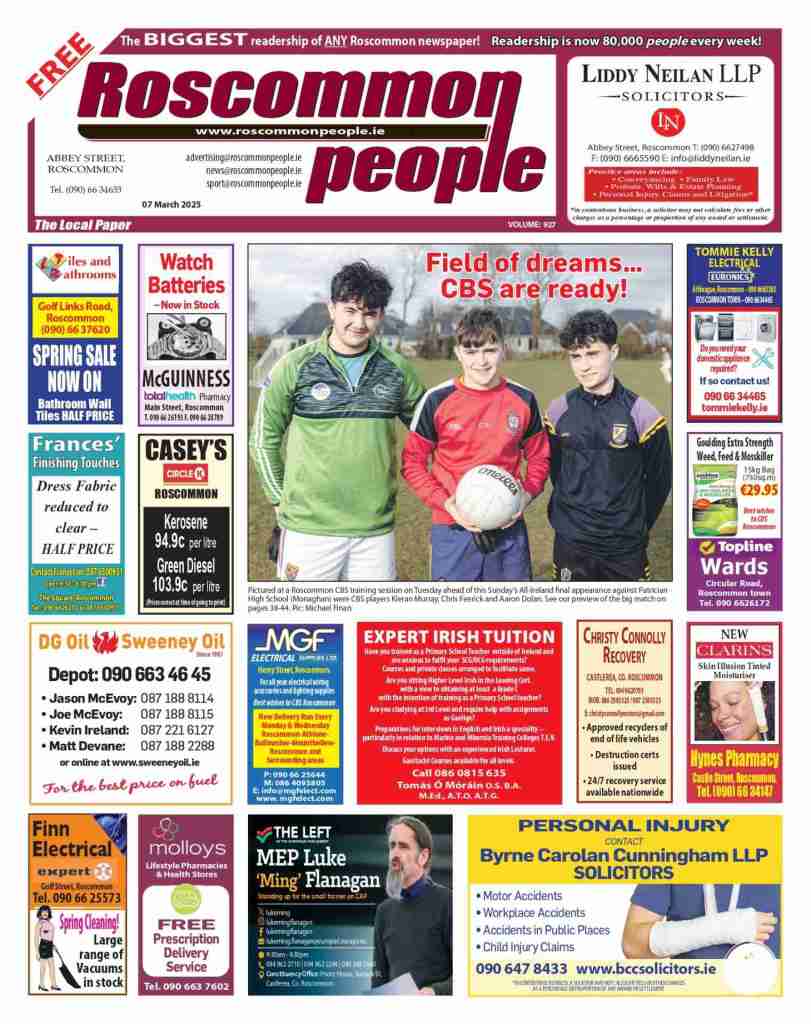Very few of us will ever forget the bitter controversy and explosive political row that followed when the decision was made in 2011 to close the Accident & Emergency department at Roscommon County Hospital.
These were extraordinary times in the county, and indeed the Dáil. Then-Fine Gael TD Denis Naughten voted against the Government. After what seems like an entire age since those events took place, Frank Feighan, the Fine Gael TD who voted with the Government, is now a Junior Minister.
Most of us who live in County Roscommon have since grown accustomed to not living near a hospital with an Accident & Emergency department that caters for adults. Instead, when the need arises, we make the trip to places like Portiuncula, Mullingar, Castlebar, or indeed Galway.
Last weekend, on an overnight visit to meet family in Mayo, this writer had, for the first time (thankfully) since the Roscommon closure, to experience what really happens when one has to step inside just one of those units. I was following in the footsteps of the people of Ballaghaderreen and nearby when I had occasion to have a family member treated inside the doors of Mayo University Hospital’s emergency department.
Peaceful scene
The scene was set on a very quiet and sunny Saturday morning in the Mayo county town of Castlebar. What began as a fairly innocent wrist injury at school on Friday afternoon had developed overnight into a painful and suspected bone fracture. I have to be honest. It was my bright idea to bring our young patient up the road from where we were staying to try the emergency department at the hospital in Castlebar. That’s because I genuinely thought that it might be the right thing to do at the time – to visit a modern acute emergency room. But that is not how it turned out.
One of the factors that swayed me was the great proximity to the emergency department. The Google Maps app told us we were just six minutes away from the professional medical care, so it seemed a no-brainer to get the young man up and away early on Saturday morning. I had dropped off the patient just before 10.45 at a hospital which had all the desired semblance of calm and control about it.
For starters, I couldn’t see sight nor light of an ambulance in the vicinity of the front doors, and even better, I couldn’t hear one either. The set down area was relatively quiet and there were even two places to pull up and let out the patient and his mother. I’m afraid the scene was somewhat different inside the building.
Patients arriving at Castlebar Hospital are firstly directed towards an assessment unit reception zone. My young man took his place in that area along with seven other people. The check-in process took about 7 or 8 minutes to complete, with signage in the area now confirming that patients using the hospital would be asked to pay up front for the service. (The policy heretofore was to send out a bill following a visit, but that seems to have changed everywhere now).
The friendly receptionist, possibly suspecting the wait ahead, informed us that she would not take the payment until our boy returned to the waiting room after the assessment. In retrospect, we should have known that something was not going to go well.
Traumatic experience
Waiting for an assessment in Castlebar Hospital, no more than in all the other busy ones around the country, is not pleasant. In fairness, the young lady on the desk had done her best to personalise the experience by not only admiring my son’s Roscommon football jersey, but suggesting he would definitely be seen, even with that attire on his back – i.e. despite the fact we were firmly in the heart of County Mayo! But I’m afraid after that nice welcome the rest of the experience in the unit went downhill rather quickly.
The next step was to go into the main A&E assessment area where a young nurse again asked the patient to sit on a chair in the corridor. For the next ten minutes, our 13-year-old patient sat there while awaiting the assessment, in the company of other patients who were in the same boat, so to speak. The problem with this arrangement was that one of the patients just ahead of him – inside one of the cubicles – was an elderly person who was already finding the experience upsetting and who simply didn’t want to be there.
This poor lady seemed to be highly distressed and was clearly suffering from onset of dementia. The problem here again was that her cubicle curtains were open – her privacy invaded, her distress very clear, and the experience of having to watch and listen to her trauma having an equally distressing effect on the 13-year-old child in the Rossie jersey and his mother.
Save from actually sitting through the trauma and pain of an actual operation in a hospital, this must go down as one of the most difficult, hurtful and embarrassingly awkward of moments. One feels not only the ordeal (for her) of the woman’s assessment, but a lack of respect for the elderly lady in distress at being there at all – as well as the discomfort of the 13-year-old child who doesn’t want to watch it or hear it either. It all points to the most stomach-churning of moments.
Unacceptable
Driving home from Mayo later, I listened to the words of Minister for Health Stephen Donnelly who admitted that emergency department delays are “completely unacceptable”. He said there was a need to go hospital-by-hospital and emergency department by emergency department to find out what is going wrong. On hearing these words, we all sat up immediately in the car and were ready to offer an opinion!
Minister Donnelly was speaking at St Finbarr’s Health Campus in Cork city after reports of lengthy delays for admission to emergency departments – but in truth he could have been anywhere.
Latest HSE figures show that people over the age of 75 are waiting an average of 24 hours to be admitted to emergency departments once they arrive at any hospital in the land.
Back in Castlebar, within a very short time the absolute honesty and professionalism of the staff member on duty for the assessment shone through. “You might be better heading back to Roscommon County Hospital and the minor injuries unit there” our boy was told, confirming that it would be hours before the patient in our midst would even be X-rayed, let alone treated/admitted.
An hour and a half later, the young man in the Roscommon jersey was indeed back in the controversial building on the Athlone road, assessed in a private room, had completed his X-ray and had his diagnosis delivered. A break was indeed discovered and appropriate treatment arranged. His ordeal was over. The treatment at the minor injuries unit in Roscommon was superb. The speed was incredible, and one was just left to wonder why the same could not be achieved at a major emergency unit at a modern acute hospital.
Throughout all of the above experiences, two things shone out at the weekend. In the first instance, the staff were professional, competent and very nice at all times – but the conditions were testing, traumatic and quite disturbing.
In these circumstances it is easy to see why so many of our young men and women with medical degrees are turning their back on our shores, and emigrating. One such doctor sat on the sofa in our home in Ballyleague on Sunday afternoon and confirmed this was the very reason he left – a combination of so many testing conditions on the ground, and a lack of investment, medical support and back-up combining to push him out the door. Who could blame him?




